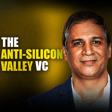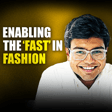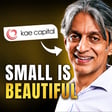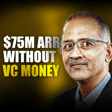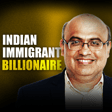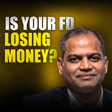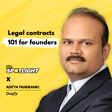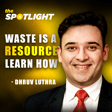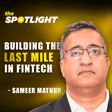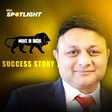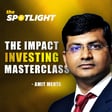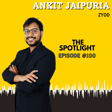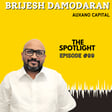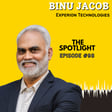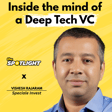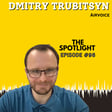Become a Creator today!Start creating today - Share your story with the world!
Start for free
00:00:00
00:00:01

Reshaping women’s health through AyurTech | Rachana and Vishal Gupta @ Gynoveda
Entrepreneurs globally are pioneering new categories to address both lifestyle and chronic diseases through the ancient wisdom of Ayurveda. Gynoveda is one such innovative startup revolutionizing women's health by seamlessly blending Ayurveda with cutting-edge technology.
For more such interesting founder journeys, subscribe to our newsletter www.founderthesis.com
Transcript
Introduction of Ranjana and Vishal Gupta
00:00:00
Speaker
Hi, I am Ranjana Gupta and I am the co-founder of Gynovil. Hi, I am Vishal Gupta. I am the founder and CEO of Gynoveta.com.
00:00:21
Speaker
As the world rediscovers the magic of Ayurveda for health and wellness, entrepreneurs are discovering and creating whole new categories for solving lifestyle as well as chronic diseases through Ayurveda. And one such startup is GynoVeda. GynoVeda is approaching women's health concerns with a novel combination of Ayurveda and technology and the founders themselves are a novel combination of husband and wife pair of Vishal and Rachna.
00:00:46
Speaker
Stay tuned for insights on how to build and scale a health and wellness T2C brand with a very focused target market.
From Friendship to Founders
00:01:03
Speaker
So let's begin at where the two of you met. And I mean, you're not just co-founders, but you're also like a husband-wife couple. So let's start the story from there.
00:01:19
Speaker
Well, I think, you know, Rachna and I, we are childhood friends, you know, we went to the same school. We almost went to the same college, which is Mitu Bayan and NEM in Mumbai, which is the part of the same campus. And we've been knowing, you know, I mean, each other almost for 47 years. Wow. 47 years. And in school, while we never knew, obviously, you guys are like,
00:01:45
Speaker
50 plus today. You know, amazingly young. Both of us are almost touching 48. I think we have been together now married for 23 years and before that seven years together. So, you know, essentially 30 years of relation as husband and wife.
00:02:10
Speaker
And as founders and co-founders, I think the last four or five years have been a fabulous journey. I think we have discovered and rediscovered ourselves as individuals and as couples.
00:02:25
Speaker
How did, what were your career graphs like once both of you graduated, what were you doing in corporate world? Like what skin sets did you have when you got inspired to become founders? Just to understand that.
Vishal's Entrepreneurial Journey
00:02:39
Speaker
Look, I come from a Bania family. I'm the first one in the last five generations that went on to do a job. All my other
00:02:48
Speaker
you know, you know, by the father, grandfather and beyond, they all had their own businesses. So I started my career by starting my own business as expected and did that business for four or five years. It was an internet website development business, you know, they can agency web design agency in 1996, you know, making website was as cool as charge GPT today.
00:03:14
Speaker
So, you know, that's what I did. I had a 150 member team, enjoyed the dot com boom and the dot com doom, graciously closed that company and realized that I need to pick up some skills having, you know, to really build a scalable business. After that, I worked with some of the sunrise industries of last 20 years.
00:03:36
Speaker
BPO was around the corner in 2002, so I became a part of that. After that, I've been a part of an online travel agency, a company called Clear Trip. And after that, I've been a part of GEO, you know, I was a part of Logstein. I've been a part of ACO.com. In work functions like sales, marketing, work. So when I think I've played multiple roles, like for example, I picked up my operation skills in call center, and global operations is what I picked up in, you know,
00:04:06
Speaker
which was a company for. In ClearTrip, I worked with three or four functions, operations. The other one was building the retail chain, which we eventually closed down and build the hotel business for ClearTrip. So it was business development essentially.
00:04:26
Speaker
When I went to GEO, I developed the My GEO app. So I was a business head of that. Having come from the call center, it was about focusing on self support, which is how can you eliminate this whole need of calling up somebody, emailing somebody. So that's the skill of app development that I picked up there.
00:04:45
Speaker
Akko was again as a head of operations building the initial traction and bringing things together, being a part of insurance space, being a part of BPO, being a part of travel and before that website, all of it, the common theme has been technology and digital. And I couldn't think of anything better in GynoVida, in GynoVida everything has come together. So being a generalist all my career,
00:05:14
Speaker
And you know, the thing I know is how do you deal with the exit? Okay. That's
Rachna's Career in Marketing
00:05:20
Speaker
now, what about you? This is my most favorite part, because this is where I completely get to speak from my heart. Vishal said, honestly, a journey that we've spanned together for the last more than 20 years, we both, we have an 18 year old son. And so literally kind of living the entire teenagers world right now through him.
00:05:42
Speaker
I never realized we're going to be life partners one day turning into business partners, but I think it's extremely great. So let's thank Phil for that. So my qualification has been because a commerce graduate went on to do my MBA in marketing and then spent almost over two decades in the business process outsourcing industry. I worked with very large women-centric teams, both in my old swine organizations, which is IntelliNet and then
00:06:12
Speaker
consent and teleperformance and I think somewhere down the line very clearly the women advocate in me has always been very strict and little did I know at that point of time that I'm going to do something about it but I think it was always there and I spent a lot of time in the customer experience.
00:06:34
Speaker
in customer relationship management, mapping the entire user journey together, understanding the nuances of what consumers want, customer satisfaction, how do you build robust transaction, quality monitoring, training, operation,
00:06:53
Speaker
And I think that experience is something that has been very enriching and now which is of course coming in very happy. And like Vishal said, I think he's always been an intentional entrepreneur because coming from a Bania background.
00:07:08
Speaker
you know, flew naturally into his jeans. I come from a background where it's always been, you know, get a job, do well, throw up the rank. So, more like a very short space. And so, you know, at the sound, at the bust of sounding keychain, very clearly an accident.
00:07:25
Speaker
Who came up with the idea? Was it? There are typically two parts. Someone says, I want to be a founder. And then they start looking for an idea. And the other part is, someone is inspired by an idea and hence they become founders. What was it for you guys?
Inspiration Behind GynoVeda
00:07:44
Speaker
It was actually in both of us arriving at it without having to sit each other down and say, hey, this is what we are going to do for the rest of our life. I think both of us were in our mid-40s. And at the time when we were doing extremely well in our respective careers,
00:08:04
Speaker
When I think something happens, you know, when you don't, and a lot of people think it's midlife crisis, but I'm going to call it as midlife clarity. I think you realize that there is a lot more meaningful purposeful thing that you can do, but you don't really have, you know, a very clear idea about what you want.
00:08:24
Speaker
And there was a prevalent track running in our lives at that point of time. Vishal was dealing with an autoimmune disorder called psoriasis for over a decade. And he had tried everything. What are the symptoms? I've not heard of psoriasis. In psoriasis, there is skin breakout. The skin starts scaling.
00:08:46
Speaker
uh in in a very practical information kind of you know effect and I was also dealing with asthma you know so I think dealt with it you know for five seven ten years thanks to the night shift for seven years in BPO space uh completely ruined my you know whole uh whole hell and I think that's where after trying you know several pathis alupati homupati you know I tumbled upon Ayurveda and uh surprisingly you know
00:09:13
Speaker
It worked wonders and it's been now 79 years. I've not had a relapse and I think that kind of was a tipping point where as a family we started recognizing that there is something about Ayurveda that works.
00:09:31
Speaker
Having now tried for seven, eight, nine years for most of the family members and people around us, in fact, people started asking that you guys are so passionate about Ayurveda and you keep advocating about it. Why don't you guys do something in that space? And I think in our own small capacity, Rachna and I went fine morning over Chai Picharcha while being on the jobs. We said, why not?
Ayurvedic Clinic to GynoVeda
00:09:58
Speaker
I think there was a bigger, there was a pain point. The pain point was every time we wanted to go to an Ayurvedic doctor, we would find it very hard to find one. I said, when you are finding it hard to find one, let's create one, right? And there are enough and more doctors. So Rachta went out, she searched for, she met like 100 doctors in Mumbai, out of which we personally went and met 30, 40 of them.
00:10:20
Speaker
eventually found this brilliant, you know, Dr. Vishraksana, you know, in fact, in a, he's in a better position to talk about, uh, and the whole journey of, uh, you know, creating the clinic eventually, which led to creation of Guaido. Yeah.
00:10:34
Speaker
So I think I had more doctor contact in my phone than I had of my family and friends. I think that was the kind of obsession which is needed because this is literally, like I said, both of us are non-doctors. We had experienced the miraculous power of Ayurveda. And I think in some sense, there was a complete transformation that had happened in our lives, Ashay.
00:11:00
Speaker
why we had always believed earlier in modern medicine, but I think what Ayurveda to dig to us as a family was life change. And so the need to see how that can back to at least our loved ones, pretty much the concept started from there. That's when I went out, I actually pitched to a lot of doctors, trying to understand that what can we do with them together.
00:11:27
Speaker
But at the end of the day, they're all doctors at heart, right? So it's not like everybody really wants to start a business. But from this really young dynamic, I would say almost a prodigy in Ayurveda. And convinced him and said, we are going to invest in your clinic. So we eventually invested in a clinic in Santa Cruz East in Mumbai. And this was 2018.
00:11:46
Speaker
And this post-hand we got to witness the power of Ayurveda getting unleashed even on women's health. Until then we had seen it also. Rices in Vishalski, we had seen for diabetes, we had seen it for you know, Rifstein disorders like asthma, arthritis, but we had not seen anything
00:12:07
Speaker
on women's health. And at the clinic where I think it was absolute revelation for us to see what kind of an impact it was doing. But it's a root cause permanent solution. And that's when I think the aha moment happened.
00:12:24
Speaker
So once you invested, then you would also go sit there, man the reception, stuff like that. That's how you got that first-hand experience. Yes, up to the women coming there, really. And young women, right, in the age group of anywhere between a 25 to a 35, asking them if they come there on their own, did they come there because their parents pushed them. What was the rationale behind coming to Ayurveda? And what problems were they coming with?
00:12:52
Speaker
They were coming with mental and reproductive health issues. So PCOS, which is the polycystic ovarian syndrome. They were having issues with the regular periods. They were having issues with fibroids. And most of these issues actually were chronic enough for them to get surgical intervention.
00:13:11
Speaker
And through Ayurveda, they were completely, you know, it eliminated the need for them to go for any surgery. And it brought them back on track, anything between four to six to nine months, depending on how chronic or severe the problem was.
00:13:28
Speaker
So I think the belief just intensified to another level. And it also opened up this landscape, saying that on and on, we weren't looking at Ayurveda only for the market, which was already there. It opened up a completely new segment for us, which is Women's Hill.
00:13:47
Speaker
And I think between Vishal and me, we clearly know what our strength was. So Vishal had worked with the Internet, he had worked with digital force, peer e-commerce operations was something that Vishal understood. And I intuitively came from the world of consumer experience, women's health, putting sentiments together. I think that's...
00:14:09
Speaker
This is a market that we should not open. You know, there's this famous Maya Angelou quote, which I always say that, you know, it says, I'm interested in women's because I'm open. I would be a fool not to be on my own side. I think that kind of, you know, took center stage and both of us decided to do something about it. The name Dinovida wasn't clearly there.
00:14:34
Speaker
But we also realized that we couldn't have a generalist doctor. We need to have a specialist. And again, back to my search of now finding an Ayurveda gynecologist, which is very rare and few in the country. Again, tumbled upon our third partner, who is Dr. Tarthi Bharti, and she's the chief gynecologist and an MD Ayurveda.
00:14:58
Speaker
again, went and pitched to her. So I think I've done work, which is to doctors and I'm done to invest in my own. Difficult is difficult. Did you have clarity on what you're building? Are you building a product company? I mean, today, of course, you're like a DTC brand, but at that time, did you think that you will become a product company or you open a chain of clinics and experience centers, you know, like say you have these Kaya and all of these.
00:15:25
Speaker
What was the early vision? Look, I think the vision was very clear that when I looked at, when we identified that menstrual related reproductive system related issues are what is cropping up and we can solve that. I think the number one question was how big is the problem? And what is like in the business parlance, total addressable market? And what was the quickest way to find it?
00:15:55
Speaker
There were two routes that we took. Number one route that we took was, let's find out what is a Google keyword volume. And after having analyzed somewhere close to 24,000 keywords related to menstrual space, we figured out that in the online space alone, that means people who are reachable online through online channels like Facebook, Instagram, social media, Google, and so on, is in the range of seven to eight grown women who are already searching or looking for help.
00:16:26
Speaker
The second piece is, you know, we kept reading in media, you know, that, Hey, one in every five women have, uh, you know, some of the other issue and the sample size for a certain thing that used to be like 200 people, the survey that they extrapolated that, you know, 130 billion, 130 crore, you know, population X, Y. So we said, why not do a primary serve?
00:16:50
Speaker
And that led to the birth of the world's first period test. In today's parlance, it's called artificial intelligence. We didn't know what is artificial intelligence. We just asked five doctors around us, including Dr. Arthi Patil, who is now a co-founder, that if
00:17:13
Speaker
patient walks into your clinic, how do you do prognosis, which means you know diagnosing the problem with verbal communication or with other means and not going for a blood test or any serography and so on. And she said I asked these 20 questions.
00:17:33
Speaker
And based on that 20 questions, I am able to ascertain, you know, whether there is a problem or not. We said, can we convert this human intelligence into artificial intelligence? And that gave birth to the first period test of the world. That period test since 2019 has been tried by 6 lakh women across 40 countries.
Online Education Model
00:17:54
Speaker
And we've got one of the largest database in terms of intimate health information. And that kind of ascertain that that's the space we want to be in. It's a large market. It's a big problem you're solving. And we had no clarity as to, oh, you know, we'll go this way, we'll go that way, but we definitely knew we'll not go the clinic route to begin.
00:18:22
Speaker
because it's an asset heavy, hard to find doctors. And difficult to scale. I had done all my life, right from my earlier career of developing website, to doing ClearTrip, which kind of scaled very quickly to doing Aco, to doing Geo. All of it had one thing in common, which is a digital thread. I said, both Raksan and I said, can we take this online?
00:18:52
Speaker
and play this out online where we will educate consumers that this is what Ayurveda can do for you if you have period problem and here is the product. And if we just, you know, zoom out a little bit Akshay, when we talk about marketing and when we talk about building a brand, essentially brands are built by spending money. If the category already exists, say for example, personal care or face wash,
00:19:22
Speaker
If the category exists for that many years, if you're a new brand, you will have to spend money in emerging as a top-of-the-mind brand. That means there are 30 other brands. You want to become the top brand, spend some money and immerse to the top. Or it's a non-competing space, virgin space, blue ocean, green field. People have a need.
00:19:48
Speaker
But they are not having the demand. That means, hey, you know, that means the need is there. But the guy who goes first and creates the category has to convert the need into demand. And then eventually have an offering that converts demand into revenue.
00:20:18
Speaker
in the case of a category that already exists, cut shorted by demand generating into revenue. So for us, actually, the model was broadly clear, the online career, consumer capacity directly. And that has the second huge advantage, apart from scalability, is that you get to speak to the consumer directly.
00:20:45
Speaker
And when you're building a category, that is wealth. Information that you're gathering from the consumer will help you iterate your product, iterate your offering, iterate your various process systems. But if you go B2B, like if you go via a doctor who will in turn dispense the medicine of prescribed, I will never get to meet a consumer. So that was the second piece that was clear to us that we want to directly talk to the consumer.
00:21:16
Speaker
So I think going online, selling it via website, directly talking to the consumer, educating them, these were the things that were clear in 2019. Obviously, none of us knew that D2C
00:21:32
Speaker
And when we started, we did not even know the word D2C. It's only when we raised money and we became a part of five side portfolio company, investors educated us. Oh, by the way, guys, this is called D2C. So yeah, I think that's me.
00:21:52
Speaker
So the traditional way in which a gyno related problem would be solved is a woman would visit a doctor. The doctor would do prognosis by asking those 20 questions based on which the doctor would come to a conclusion that this is the problem. And for every problem, there would be a fixed product that would be prescribed along with a
00:22:18
Speaker
frequency and how to consume and whatever other instructions and maybe some lifestyle change instructions, et cetera. So all of this could be digitized. Like the prognosis part of it, you could digitize through like a questionnaire, online questionnaire with an algorithm behind it that is able to arrive at the same conclusion which a human doctor arrives at. And then
00:22:42
Speaker
give a recommendation that this is the right product for this duration and be the additional lifestyle change. So that's what you wanted to build, like a digital version of physical consent and selling off the product process. That's correct. I think we went on to build that. It continues to be there on kindofwither.com. And the way we went about bypassing this whole need for going to the doctor,
00:23:12
Speaker
was to be able to self-care. So the whole underlying theme was self-care. How do we educate you to know your body really well? Educate you on what is the root cause if you are facing these symptoms. Because, hey look, I think, and Rachana can speak a little more about this, but you know, if my periods haven't come for the last 60 days,
00:23:40
Speaker
I mean, you don't have to diagnose that a woman already knows. What she wants to know is what is the solution and why is it happening to me. And that's exactly where we said let's use this model of content to commerce. Let's record the videos, explain her why this happened and what she can do about it. And here is the product that can solve the problem.
00:24:08
Speaker
I think that is how in fact a doctor would also, if you go to a doctor and you tell the doctor, hey look I am not getting the details. Can you help me do that? Can you help me understand? While doctor may not be able to explain the whole science behind it, we just said, can we make this an awesome experience by even explaining science about it. Why this is happening? And how do you solve it and how really Ayurveda works? We may rush back and add a little bit of that on the community aspect.
00:24:40
Speaker
We knew we had a product that, so the solution was very clearly identified.
00:24:45
Speaker
I think the missing blocks that had to be established at that stage was one, how do you post identify women who are dealing with this? Because you don't have an offline sector, so it's not like somebody will just walk in into your clinic. In an online space with whatever filters and targeting you do, how do you get women to open up about their most intimate health problem, mental, reproductive and vaginal health?
Community and Retention Strategy
00:25:14
Speaker
And I think that's where we test that we built and we had over six lakh women who had responded and taken the test. I think that insight was super precious.
00:25:26
Speaker
insight toward us everything about you know which area to focus on. So clearly PCOS is regular period vaginal infection. These were the three biggest disorders that came out and we said with a very lame pee and actually just you know upon the words of getting funded where do you really prioritize and do you want to say you know do you want to go make yourself overly thin or do you want to get deep into a problem.
00:25:57
Speaker
And how you convince women that Ayurveda has a problem because her entire conditioning over the last 20-25 years is that you have to live with it, you have to manage it. So I think we had two big challenges. One is identification of women who were dealing with these disorders. And second is the entire education. You know, the whole idea of awareness, interest, desire, action. Literally, how do you bring that framework out?
00:26:26
Speaker
And I remember during our early days there was no choice but to chat with women. And that's how actually I started by chatting along with Dr. Aarti Padil and just one team member that we had and today she's still a part of our team in 2019. Chatting with women, answering over the rebuttals or questions they had and then somehow convincing them that at least try to cuddle.
00:26:59
Speaker
But very quickly also realized that this is not a skill level.
00:27:04
Speaker
I mean, then you're going to build an army of call centers just to get your lead in and conversion. What exercise gave us was, again, any deep consumer insight saying, what are the top three or four things which a woman is looking? And what is the persona of women that you as a brand, when you're just sitting out, you're going to be talking. So when I say persona, I think very clearly we said these are going to be women who were aware of their problem.
00:27:33
Speaker
And these are going to be women who also knew that the current treatment that they are taking is harmful. And it's suppressing the problem. It's not treating the problem. We said, let's go after them. And let's narrow our education and our content and our website product page to speak to these women. So we used all the learnings from chat and converted them into long-form content.
00:28:00
Speaker
brought out doctor's length content and I was very clear at the beginning that they are going to only have real women on camera talk about their
00:28:11
Speaker
So it was very easy to get influencers and just spend money and get women to talk about your problem. But I think it would have defeated the authenticity of the brand and the space, especially because these are digestibles. You're not applying something externally. So what you consume inside your body has to be something that you know for a fact that you can trust and you know what is the early signs of progress. And only if somebody has taken it, she can talk about it.
00:28:40
Speaker
So yeah, I think using consumer insights, using all the learnings from sharing it with Vishal, he built the website, he built the initial landing pages and that's how the journey began. And this was, you know, March 1, 2020 is Vinari Kaur's website. You know, what happened to the world, three weeks thereafter. One question I had here.
00:29:09
Speaker
What was your product range and how many SKUs did you launch with? We had seven SKUs.
00:29:19
Speaker
And these were, one was PCOS, the second was irregular periods, the third was vaginal infection, the fourth was for heavy bleeding. So these were the SPUs that, but we very clearly knew 80% of the women who had PCOS were falling into a category where they were having D.J. and periods. So we said, let's use the Pareto principle and run off the women that we really will be able to make it.
00:29:49
Speaker
Okay, got it. And you did not necessarily need that complex consultative selling process here because these are low risk medicines. Like there is no risk if somebody self-medicates and has excessive medication or takes the wrong medication and all because it's Ayurveda, so it is fundamentally low risk as compared to allopathic.
00:30:12
Speaker
So what I would say, more than lower risk, Akshay, I think that we were educating everything. Why does the problem happen? How will Ayurveda treat it? And what do you need to do? Right? Medicine has diet plus through webinars and through the community that we build them was instant unlimited doctor support provided to them. The only difference was you're not physically going to a doctor.
00:30:41
Speaker
You're doing it all through digital channels. And I think because it was COVID, habits had changed. Women were already used to doing online consultation, online webinars, attendance. So I think somewhere that phenomena was something that we were able to leverage even further. And it kind of fitted into their user behavior of doing things naturally.
00:31:08
Speaker
Essentially, the community replaced the consultative process. That's right. Community and content replaced the consultative process. Absolutely. And the community was not bent to sell product. The community was bent to provide value. Every single FAQ that the concealer had, we wanted her to get instantaneous response and from a credible source, which is a team of doctors.
00:31:31
Speaker
So I think the focus was, can we bear the largest safe, non-judgmental, non-inclusive space for women to actually just open their heart out? You may not even purchase the product, but you find it easier to speak to a stranger about the vaginal infection you're going through. And because you fear being judged when you talk to somebody, no. That was the ethos when we stopped the community.
00:31:57
Speaker
And today, our board of the business is the fact that we bring the largest online community on next year. Where have you purchased this? Which platform?
00:32:12
Speaker
This is currently hosted on Facebook. It's called Circle of Sisterhood. And truly, as the name denotes, it's truly a sisterhood of women, different age groups, different parts of India, different socio-economic demographics, but all united in one green to get freedom from their period of problems and truly to become a best version.
00:32:38
Speaker
Okay. And how did you build this up? Like, you know, what was the way to scale?
00:32:45
Speaker
So the way to stay was when we built it up, I literally had to call up our consumers, who were purchased, and request and complete them to come to the community. Because they were like, when you join this community, I have to literally convince them that what is the benefit that you will get when you join this community. So I think the premise of bringing the first 100 women was obviously re-reaching out today.
00:33:15
Speaker
What happened was, and at that point of time, Dr. Dardheen and I would also very extensively do webinars for them, answer all their questions. So we would, similarly, like the session record, the webinar, put it out in the community, more engagement happened.
00:33:30
Speaker
They realized that some women were coming out and talking about the changes they had seen, periods coming back on track, overall energy feeling good, no longer having a problem of, you know, body shaming, body positivity was happening. They were very free to talk about it in the comments.
00:33:49
Speaker
So I said, okay, let me take a step further and I requested them to come on camera and I said, would you be okay to share your narrative and just inspire maybe one woman in this world with narrative, if that could make a difference? And surprisingly, they were absolutely okay. There were many women who were not okay because it's still considered taboo. They had to ask their family for permission, but I think larger picture was the mission was accomplished.
00:34:15
Speaker
that did not want to depend on influencers who had not consumed the product, but truly can add women from the community because advocates of the brand. And so I think constantly giving to the community what the community wants and not what a brand wants to do, I think has been...
Funding Milestones
00:34:36
Speaker
How do you weave in commerce into communication? There's a Facebook group. We were not chatting with each other. I was sharing questions, et cetera. I was sharing answers. How does commerce get driven through this? Well, I think, you know, I'll just bridge that, you know. We never actually, like Rachna said, you know, one lakh community members, and it's been three years. Actually, we have never mixed commerce and communication.
00:35:05
Speaker
and that's what Rachna's vision has been, that provide women a safe place to open her heart and discuss what she wants. But I think that's subtle branding, because when you are talking about people's problem and how do you really solve it, it is people who are saying that, hey, you know, I had this problem and I took kind of with the product, then it kind of worked.
00:35:31
Speaker
And they are posting their success stories by themselves. We are not. So it's absolutely user-generated content. And Rachna is the host for that. And she's just facilitating from her heart. She's out there to just help women who are reaching out. And just to elaborate that, I think my powers isn't out.
00:35:54
Speaker
of what you do, right? Truly, the input is community building, revenue, costs, and outcome. I think what happens is, actually specifically, for Ayurveda, it takes anywhere between four to six to nine months to see results.
00:36:09
Speaker
And so even when she starts seeing the first sign, or if she starts seeing something which she believes could be a sign descent, but there is a doctor and a moderator there like us telling her that, hey, this is wrong. If this is happening, it's a good sign. It's a sign of detoxification. You know, your toxins are coming out.
00:36:29
Speaker
Her answers are getting addressed. And that is what further leads to the confidence that I'm not alone in this journey. They are with me, which is that I know with that team, I am mad for the women, you know, who are going through the same phase. So I think there's not a solidarity building that happens. And that leads to them making a repeat purchase. So do your answer around callers, right? It's a retention.
00:36:58
Speaker
that they purchase the product, they become a part of the community. We do webinars, we talk about women's stories, we appreciate women celebrating their milestones, give them information, it leads to repeat and recurring customer's dates. So that's how the goal was done. Interesting. This is the first time somebody is telling me that community is core purpose should be retention and lead generation. Interesting.
00:37:27
Speaker
So, you said you raised your initial seed round I am guessing, when did you raise and how much was that? We raised our seed round in November 2019 and we raised a million dollar then and subsequently that was that was our seed round and the series A happened which is a 10 million dollar round in March 2023 very simply just 600.
00:37:52
Speaker
who led the Sidram. Sidram was led by this wonderful, you know, venture capital of very, very popular firm called Fireside Ventures. Founder of that is this wonderful person called Kavaljit Singh. And I mean, Fireside is known for its investments in Mama Earth,
00:38:13
Speaker
And we were among the first few who were able to convince Kaval and Vinay, who are partners at Fireside, who believe and share our vision and invest in us almost like in a pre-revenue, pre-product.
00:38:36
Speaker
OK, amazing. And that 1 billion would have helped you in terms of building your online D2C website. And how did you create the inventory of products? Was it third party manufacturing? And were these proprietary products? Who was the IP for it? Help me understand the launch.
Product Development and D2C Launch
00:38:57
Speaker
Like first March, when you launched, what are the pieces you put in place for that?
00:39:01
Speaker
Look, I think one of the things that we had by virtue of Dr. Arthi Pati being our co-founder and our knowledge partner is that she, by that time in her 10 years career, she had already treated thousands and thousands of patients. So she knew the formulation that works and that doesn't work. What was missing was a convenient form of product.
00:39:28
Speaker
She was giving the consumers five different products because the formulation that she wanted was not readily available in the market. And that was an innovation guide. Can we combine these 40 herbs to a single pill that works for PCOS? So our initial investment went into iterations in getting the innovation piece.
00:39:54
Speaker
And then came the whole iteration of, now that we have innovated the pill, does it really work? So we iterated on the efficacy part. That's the reason why today, Gayanurveda's products are super efficacious, is because of the sheer grunt work that happened in the initial day.
00:40:14
Speaker
So, we have changed the whole product form from a liquid karwa kara to a pill which is convenient to consume, convenient to ship anywhere in the world and extremely affordable. So, I think that is the initial part. Then the second challenge was how do you really communicate this well to consumers and that is where
00:40:36
Speaker
the whole science behind the product page on the website and the video, the carousel, the brand building, a huge portion of investment went into getting the packaging right, getting the whole technology piece right. Now, how do you really communicate on camera or your visual?
00:41:00
Speaker
If you go to an agency, the bills are pretty big, you know, and it takes a lot of time. So we invested heavily in content team internally, the whole equipment. So we built our own studio to be able to dole out the content because we had this vision of being the thought leader in the category that we teach. So I think the overall investment went into all those areas, which is the content creation, the product creation,
00:41:30
Speaker
R&D, technology creation, all of this eventually led to being able to launch a worthy offering on March 1st, 2020, which is the reach in website. If there is one thing where the investment of heart and soul and not money that has gone in is actually the community.
00:41:55
Speaker
because you could make a Facebook group without any cost, but you cannot bring a lot of consumers without really, even if you throw money at it, the people will not. So I think everything other than community have money and we invested in that. Because we acted frugal and innovations are best done frugal, we did not utilize the whole million dollar in doing that. In fact,
00:42:25
Speaker
That's my message to budding entrepreneurs and founders that if you really have something running in your mind, you want to try something, it doesn't take a million dollars. You can actually develop a playbook and then go on to raise money. And that developing of playbook actually needs approximately 50 lakhs to less than a crore. Because that money is actually required for iterating when you fail.
00:42:56
Speaker
So that's been the kind of money that was utilized. The money after that has been all about expansion. Okay, okay. One million lasted you for like two years. The answer is yes. I mean, it's only very recently. See, I think the whole focus was Akshay in sustainable business and growing property.
00:43:29
Speaker
I'll be not looked at in the right light in my Baniya community if I were to be running a burning train. And I think they would say that, how do you really justify so much money being raised? I think I've been born and brought up in family community that believes in building businesses that last and building businesses that makes profit.
00:43:50
Speaker
I think it's a shame.
00:43:57
Speaker
So even if we raise money, I think we use the money as if it's our own money. Because end of the day, in return for money, you're giving a part of your company, which is the most expensive thing in the world. What was the attraction like from first March on? What kind of monthly revenue were you seeing over the next couple of months?
00:44:19
Speaker
Well, I think, you know, the journey of, first of all, in the first year from a zero revenue, we travelled the journey of 7 crores in a year's time.
00:44:27
Speaker
It's in hindsight looks like a very sexy story. But in the first month, which is in the March 2020, when we made our first five lakh rupee sale, we were celebrating and then 23rd March 2020, COVID happened and everything was shut. And we said maybe we are sealed to do.
00:44:52
Speaker
After two months, which is after 23 days of lockdown, then after a month of lockdown, we came back with a big bang. And in the third month, we cranked up like 20 lakhs of revenue, which mounted to 50 lakhs, which took some time to mount to 60 lakhs. Eventually we closed the whole first year with like a 7 crore in revenue. And I think for a company of category building space, that was
00:45:22
Speaker
called good enough traction. That means that's called a product market. That means that your first 10,000 consumers have used your product. They have written a Google review. They have given you feedback whether the product works or not. Are there any side effects?
00:45:43
Speaker
Does the product show any signs of long-term effects? I think the product market was clear that it's not 100 consumers that have bought, but it is 10,000 consumers. And that 10,000 consumers in the next year became like a lack consumer. And today we are sitting at 4 lakh consumers.
00:46:05
Speaker
Okay, amazing. You know, there's this ratio which VCs like to look at, which is like the CAC to LTV, like customer acquisition cost versus the long-term value of the customer. Like how much would you earn over lifetime? What is that ratio like for you? Like, you know, our CAC to LTV to CAC ratio, the way we look at this is that we take about seven months to break even on our CAC.
00:46:35
Speaker
So our CAC is around 600, 700, anywhere between 700 to 1,000 based on the kind of product that we're selling. And our LTV over our 18 month period is about 5,000. Is it predictable? What will be their purchases each month?
00:46:57
Speaker
And now we have we have cohorts all the way running from March 2020 till now. So it's fairly a science as to how much will that end up in 12 months, 18 months, 24 months. But our effort is.
00:47:15
Speaker
that how do we prove it by 3x. That means when we started selling say for example one of our product that is a best seller which is fertility pills, when we started we were learning. So the first six months our LTV wasn't really that great. As we learned we educated the cohorts
Customer Education for Retention
00:47:37
Speaker
and those consumers that we are acquiring new, and they stuck around for a longer time. And then when we understood further, and then we implemented changes in the retention journeys, and how do you communicate? What do you communicate? It only became better. So I think retention or repeat purchases is a function of how well do you educate your consumers, make them aware about
00:48:02
Speaker
The dos and don'ts set clear expectations. I think false expectations never work. I mean, Ayurveda takes time, starts to show its magic in six months. So we say, if you are looking for quick fix and you're expecting things will work in a month's time, you're better off not starting at all.
00:48:24
Speaker
I think that also we learned over time that set clear expectations. It's okay to have 50 customers versus 200 customers, but those 50 customers will stick around for a longer period of time as compared to 200 customers out of that only five will actually stick. There is this conflict for a customer. The best possible outcome is that they don't need you anymore.
00:48:51
Speaker
that they turn. Sure. And I both have a perspective on that. I'm sure you're going to come back. It's like exactly like the doctor business, right? You go to the doctor for X problem and you know, you get cured, you know, you think get wet.
00:49:17
Speaker
It doesn't mean that you're not going to go back to the doctor. You know, you may go back to the doctor after a year. You may not go to the doctor for a year. But after a year, if there is some problem that occurs, that's the first stop. And there are two parts now to the business, right? One is the curative one, which is when it clearly when the disorder gets established and she's looking for a combination.
00:49:42
Speaker
So the other part is wellness. So just to take an example, pickling dish. Because it's so in your face and the whole awkwardness that you have, even if your pigmentation has completely disappeared and your skin is back on track, you still aren't worried whether am I going to look the same as earlier or not.
00:50:06
Speaker
Even if we want to ensure that women complete a lot of this problem, which they do, in our case in PCOS, in fertility, in vaginal discharge, a phenomenal result. But like Vishal said, there is your fear or apprehension, then what if I don't follow the diet anymore?
00:50:26
Speaker
And you know, so you will come out of the problem, but you want to be guilt-free and keep something on a maintenance load, whereas wellness as a category works on a very different minds. So I think what really matters to us, Akshina is one obsession with productivity.
00:50:46
Speaker
I think we leave no stone undone. Our products go through extensive clinical plans. There are clinical studies which are published in the European Journal of Pharmaceutical and Medical Research. Ipsos has done an extensive consumer study on one of our products over giant oil discharge. Thousands of open, uncentred, unadulterated consumer reviews in the communities.
00:51:13
Speaker
Product efficacy is one thing that you know we are very very focused and the second thing is our transparency of what you're consuming is not of every individual. So we put it out there in the open on the website. We mentioned what to expect every month and yeah like you know there is I think enough and more problems to be solved.
00:51:41
Speaker
Sorry, what is your product range today? You originally only like products for gynecological problems. What is it today? So we started off with menstrual health.
00:51:58
Speaker
We have now expanded into four more categories. One is the reproductive health, which is today by far our best category. So menstrual reproductive. There is intimate and vaginal well. And then there is general well, which is your diabetes, thyroid, liver. And we've come up with something for hair fall.
Product Line Expansion
00:52:23
Speaker
And also in terms of the product reach,
00:52:27
Speaker
We moved from 7 products that we launched in 2020. We arrived now at about 35. And we have another 13 to 14 products in the roadmap for this financial year. I think for us, it's not just about bringing out any product. Very closely we look at, does it fit into our burden circle? And then I think the second question that we always answer is, what is our differentiation?
00:52:55
Speaker
If the market is huge, but we don't have a differentiation, even though it fits into the wooden circle, I don't think we apply on time and effort because it's very easy to bring out the product. The hard part starts after that, is getting your differentiation, communication right and finding the audience to not just purchase, but repeat.
00:53:17
Speaker
Okay. So you would see yourself as, let's say like a modern day version of a Hamdul, which has both products which have some sort of a health use case, as well as products which are more lifestyle oriented. Well, I think the way we look at this, you know, Akshay is that there is this whole life stage from 15 to 55.
00:53:47
Speaker
And there are 400 period cycles to pregnancies and there are various life stages and requirements. At some stage it will be medicine which is required and at some stage a maintenance product. Our vision is to be able to give everything what a woman needs from the age of 15.
00:54:08
Speaker
What did it include? I think it's not. We don't look at our sense only as a product company. I think the larger point is we are an held company, right? D2C is just a medium. And that medium became glorified because of the entire wave around D2C. And plus, because COVID happened, it was a logical medium. Clearly we are in care. So it's a right amalgamation between
00:54:37
Speaker
product service content community. Would you also look at mass-market consumer products like, say, green? If we are very clear that it's going to... One, the problem has to be large. And second, like I said, it fits into our golden circle.
00:55:00
Speaker
If it does, and we have a differentiation, I know. But just because, you know, a cream is a faster way to acquire. And at least let's just get somebody into your universe of kind of Veda. I don't think that's something that we've done so far. So I think choose the battles wisely. But yeah, like I said, open to the entire spectrum of 15 to 55 years of age, what all do we will need?
00:55:24
Speaker
And making Ayurveda as a first choice, I think that's the bigger one. It's not just bringing out products, but how do you make sure that she does not look at Ayurveda as the last choice, but as the first choice for her problems?
00:55:39
Speaker
Got it. Okay. I guess, again, I'm just trying to bring in some comparable so that people find it easy to understand someone like say Himalaya, which is a range of products from consumer to health and wellness to medicinal. Okay. Got it.
Consumer Insight in Product Launch
00:56:02
Speaker
Is there a process or a science behind your decision on which product to launch next? Like you said, you have about half a dozen products in the pipeline and there are some, I think three dozen products or SKUs which are already out there. How does that happen?
00:56:20
Speaker
Great, so I think the first step, like I said, the community, what does it give back to us is passive and rich consumer insight, right? So looking at what is a complete wish list coming from our consumers, and they are the ones that are already using dino with our products, and if they are coming forward and asking for products, which means the product is bought. So it starts with our wish list.
00:56:46
Speaker
At that point of time, we don't eliminate. We just drought a complete laundry of the bust. It then goes to the golden circle, to say, does it fit into Daino Vida's golden circle of the why, the how, and the what.
00:57:01
Speaker
After that we do a complete Google keyword search volume analysis to say what is the kind of volume we are seeing on Google as when is on marketplaces and if there is a market. If the volume is messy, our golden circle has been met and if our product differentiation is clear, then it goes.
00:57:22
Speaker
If the volume is great, but we don't understand or can bring out a product there, it dies down. Or, you know, we know that freaks are golden circle, but there is hardly any one. And I'll just enamored this. So we launched some time back a product for pre-minstrel syndrome.
00:57:44
Speaker
PMS and very clearly flips into a golden circle. So there was a peak there. Borneo was massive in terms of what symptoms women were experiencing when they get PMS, mood swings, irritability, fatigue, orthopedic pain. But when he launched the product, it progressed. We just didn't have any up.
00:58:06
Speaker
And the reason being, Google's keyword research does not necessarily come into intent to buy. She's also possibly looking for home remedies. So we've had a lot of learnings. It made a tick in one of the boxes, but it has still not resulted into great revenue or maybe, or sometimes it's not made a tick here, but it's totally surpassed our expectations. So I think still fine tuning
00:58:35
Speaker
Science or this process, but yes, there is a clear path towards a new product. How do you spend your marketing budgets? I was assuming one part would be in content creation, but what else works for you? Where do your marketing dollars go? What have you learned in terms of what's giving you better ROI?
00:59:02
Speaker
So, I you know for us there are two kind of marketing one is intent based marketing and the other one is discovery one or wherever the products are fairly
00:59:12
Speaker
clear where consumers are searching. For example, they go to Google and they search for a problem. It's an intent-based market. And that's what happens on Google. Eventually, we follow them on every other media platform and show them content. If it's a discovery-based product, which is they don't know that either way they can solve this problem. They're not even searching for it. It is when we show them content and educate them on Facebook and Instagram.
00:59:39
Speaker
And look I think over the years we have learned this formula of 4 m and an a for us to be effective in our mind. The 4 m's are first of all the a is we need to be clear who's our audience.
00:59:54
Speaker
Once we are clear about the audience, you know, and what problem they are facing and what, you know, what are they trying to solve, what's their need, what's their want, then the first M is what is the message you would like to install in their head. The second M is who's the best messenger to be installing that message. Is it a doctor? Is it a consumer testimonial, one consumer to the other consumer? Or is it Tapsi Pannu, like Tapsi Pannu has been our brand ambassador?
01:00:21
Speaker
She has done a fabulous job in communicating her message to the consumers. So that's the second M which is the messenger. The third M is what is the medium you are choosing to communicate, Instagram, Facebook, social media, television, newspaper and so on. And the fourth M is multiple times. How many times are you going to show that same message so that it is edged in the mind of consumers.
01:00:47
Speaker
So I think this 4M and A has constantly kept us focused in the market.
01:00:54
Speaker
And what would be the split between, so you have what is the celebrity endorsement spend with Tapsi Padra, then you would be spending on Facebook and in all these platforms, and then you would be spending on creating content. What's the split? Content creation, you know, takes 20% to 30% of our budget. Content creation is expensive. We have in-house team, we have options teams.
01:01:23
Speaker
And the basic formula is what, whatever is the cost of creation of content, at least you need to spend five to seven times. Because what's the fun in creating the content when it will only sit on your, and when enough and more people have not seen it enough and more times.
01:01:42
Speaker
Interesting. And you host it on your website or on YouTube or on Facebook or like if you make a video. Every touch point online. So you will find that video on my website. You will find them on Facebook, Instagram, Google, YouTube. And ultimately it is the ROAS return on ad spend that decides
01:02:04
Speaker
whether consumers have liked it or not like it. Look, I think the great part about online channels is it's very pristine, it's pure, it's very honest. Give these online channels a content and give them like a lakh rupees and they show it to 10 lakh people. People are very, very unforgiving and they are very, very honest. If they don't like something, they will simply swipe up. That's your feeling.
01:02:57
Speaker
Yep, yep, yep, yep, yep, yep, yep, yep, yep, yep, yep, yep, yep, yep, yep, yep, yep, yep, yep, yep, yep, yep, yep, yep, yep, yep, yep, yep, yep, yep, yep, yep, yep, yep, yep, yep, yep, yep, yep, yep, yep, yep, yep, yep, yep, yep, yep, yep, yep, yep, yep, yep, yep, yep, yep, yep, yep, yep, yep, yep, yep, yep, yep, yep, yep, yep, yep, yep, yep, yep, yep, yep, yep, yep, yep,
01:03:04
Speaker
took away our heart and soul and it was soul crushing experience because after having seen 70 rejections you still have to smile and be up in your spirit of the 71st pitch because the 71st guy is as much a possibility and doesn't know and you can't say that I've had 70 rejections
01:03:31
Speaker
So from a soul-crushing experience, both were equally hard. In the first one, I think it was about managing your own anxieties, because both Rachana and I had taken this leap of faith together after having the salary addiction for 20 years, to let go of that salary addiction for almost one and a half years, and then go and pitch. So it was harder on a very personal level.
01:04:01
Speaker
The second one was harder at a work professional level. We had enough money in the bank. There was no need to really raise money. Funding winter was already there. So it was all about creating the watches to be able to create a massive machine. Yet, in spite of having 3,000,000 consumers, in spite of having to prove the product market fit, we are in the space of category creation. And on top of that, being founders in their middle age,
01:04:30
Speaker
We have some philosophies. We had our own set of rejections, not just in this round, which is a $10 million round, but even in the $1 million round. Because end of the day, as a couple, we don't want a third guy in the mix who not only screw up the business, but also screw up everything else. Amazing.
01:04:57
Speaker
How do how does it work as being co-founders and being husband and wife together? You know, how do you make it succeed? To make it succeed, always say why first? So in this case, that is actually is that the moment that you do also is very graciously accepted. So I know.
01:05:27
Speaker
Like I said, it's not like we've never worked with each other. And it wasn't like something we were setting up for. It just happened. And it happened so quickly that, honestly, I don't think it even hit us what we are getting into.
01:05:44
Speaker
For us, it's our friendship, literally being friends, being able to tear each other down, no sugarcoating, having our back covered by each other. So I think a lot of those things definitely is what really helped us sail through some of those. I think initially when you work as husband and wife, right?
01:06:09
Speaker
Now, I'm not saying there's a power struggle, but there's literally that need of who is that primary owner and who's the secondary owner. I think something that if it's identified and if it gets settled right at the beginning, I think it becomes easy. Like in terms of splitting decision making for these areas, you are the decision maker for these areas. Yeah.
01:06:34
Speaker
Yeah, yeah. And also what happens is that it becomes easier for your stakeholders. Otherwise, even internally, the team is going to be confused, right? They don't know who's really the commander taking the army forward. And so is the case with external stakeholders. For us, what happened was they quickly realized what our strengths are. And let's leverage us.
01:06:59
Speaker
So, everything to do with people, whether it's consumers, whether it's our internal teams, scaling from 14 member to now, you know, more than 100 member team that we have.
01:07:10
Speaker
One of that was something that I was leading from the front, because that's been something that's in my DNA have done it for decades. And everything to do with building blocks of the business when it came into strategy, when it came to putting the funnel together, when it came to SCM, Applied Chain Management, which is in back bowl. I think that's something that operations heavy was something Vishal had
01:07:35
Speaker
But yeah, I think we did go through unfair share of rough edges to say, you know, I know it all, you know, why are you telling me this? I think that happens, but for not to know. And I think I'm going to give the credit to Arij.
01:07:55
Speaker
Yeah, absolutely. What's been your learnings as founders and you are becoming founders after a very long corporate career. You must have discovered some insights on how being a founder is different from being in a job. And what's the way in which somebody who's currently in the corporate world can prepare themselves to become a founder? OK, sir. Look, I always wanted to go back.
01:08:25
Speaker
who are doing my own business. I started that way, very quickly realized that, you know, I don't have the skills for a scalable business. I need to pick that up. And I did this whole 20 years stint or 15 years stint of doing various jobs and eventually came back. So I think somewhere the hunch, the intuition was always there. But I think during this journey, what I realized is that
01:08:53
Speaker
or especially in the last four years, that realization became all the more clear. That do not believe the media, only telling you the 0.001 story, which is the success story, so much money raised, so much unicorns done and so on. That's not the complete story. So my learning and my message would be never, never, never do
01:09:22
Speaker
a startup or your own business when you're doing a job for money, it's not going to last you. You'll get very, very quickly tired, right? Because the money really comes only after you create value in the business. And value creation takes time. In the first couple of years, you'll only be iterating and money is nowhere in the scene. And if you fail to create value, the money won't follow.
01:09:52
Speaker
So if somebody is getting into this whole game of starter when I want to become a founder for money, you're in for discipline. But if you truly passionately feel about solving a problem and you are able to create a different, the differentiator or solution for which people are willing to pay for.
01:10:19
Speaker
is when you end up creating value for stakeholders in the business, stakeholders for consumers. And the last guy who will be, you know, getting value is actually the founder in that. So I think this is the reality check, which media doesn't talk about.
01:10:38
Speaker
So, I think the question is to folks who are itching to get into this whole zone, is that itch because of the whole media hype created or is that itch coming from the inner voice? If that itch is coming from the inner voice of being able to solve the problem, very passionate to solve the problem and willing to put up with
01:11:04
Speaker
very, very modest earning for the first couple of years while you're doing and creating value, then you won't be disappointed. In fact, it would be very, very gratifying fulfilling job. That's what I would say. So, were you able to take home salaries like when you raised your seed round after that or like by when did you start taking home salaries? Well, I think, you know,
01:11:31
Speaker
We, when we raised, first of all, you know, Rachna and I operated for almost 18 months without any salary when we were all on our own and had no clue that Gailurveda is in the making. But both of us were very passionate about what we would do and what was, what lied ahead. When we raised money, a million dollars, we took salaries which were, uh,
01:11:56
Speaker
you know, it's not even worth talking about. It was just because, all right, you know, the business and we have raised money. So it's fine to take a little bit up. So almost for another 18 months, the salaries that we were drawing in the corporate world versus what we were drawing in our own business, having raised a million dollars is as good as nothing.
01:12:20
Speaker
So almost three years of grunt and grind without really any promise of that 100 crore dream that every founder dreams. And if you really do the statistics, how many have a net worth of 100 crores, personal net worth of 100 crores in India? It's 0.0016%.
01:12:45
Speaker
So, larger message, don't get into this for money, get into this for wealth creation, get into this for value creation and you'll have to stay committed for 10 years. And there is any high chance of failure. What's your top line going to be by end of current financial year? It's 120 crores, 150 crores is what we are getting.
01:13:09
Speaker
Okay. And how much of this will be from online? How is it from offline? Have you started offline yet or is it all online? Well, I think, you know, this year is a year of Woomby channel.
Future Expansion Plans
01:13:21
Speaker
We have, based on consumer demand, based on what consumers are telling Rajna in the community, they are asking for meeting us, meeting our doctors, taking the first step of starting Kainu Vidha's clinic in Mumbai. And the first Kainu Vidha clinic is coming up there. Our attempt is to make a playbook out of this one clinic and scale for it.
01:13:47
Speaker
So, this would be similar to Patanjali, like Patanjali also has, where you can walk in to meet a doctor. Actually, it's a super-specialty clinic. So, it's not going to be a pharmacy clinic, it is going to be a super-specialized consultation clinic and I think the time pretty much explodes everything else that we have done so far.
01:14:14
Speaker
And, you know, I really should have done this six months earlier, but better late than never. I'm super excited that we're at the right juncture. And I think Akshay traces back to the fact that we never considered ourselves D2C.
01:14:27
Speaker
very soon we realized we are building a healthcare stack. And so this was, you know, obviously in the pipeline, it's just that you have to time your milestones right, because it's going to be capping semi. And of course now, you know, with the CDC funding, the proportion of allocation for technology, you know, scaling these clinics,
01:14:50
Speaker
And essentially I think just making Guyanoveta the symbolity and affordability as the prime focus because that will make sure that you know to what I said earlier that it will enable women to make Ayurveda as the first choice and not the last choice.
01:15:07
Speaker
So, you know, I completely understand the need to go the clinic route. I think in India or online has a ceiling. There's only so much you do. You need to be offline. But then you remember you told me the problems of
01:15:24
Speaker
going through the clinic route in the early days, you invested in a clinic that it's acid heavy, hard to find doctors, hard to scale it up. It's like a very operations heavy kind of a business, very different DNA from what you've built so far. So, you know, what is the way in which you see this being part of the overall organization DNA? How will you make it work?
01:15:52
Speaker
Look, I think our objective is to make Kainu Vida a Bharat Kapai and make Kainu Vida available at every touch point. So there are consumers that are telling us that I'm very comfortable with a virtual video call. We'll make it available. A consumer is saying, I want to come and meet you. We want to create that. We want to create an option to chat with us, phone with us, meet us.
01:16:20
Speaker
or even to the extent of franchisees of Kainu Veda, which is other doctors latching on to Kainu Veda products, the whole idea is to change lives of a million women by 2030. And for that, whether clinic, no clinic, online, all of these are distribution channels, and the next seven years is a year of omni-chan. Some will take a longer time, some will scale faster, but end of the day, these are all distribution.
01:16:59
Speaker
It's too early, but I would say that 100 cities, we need to have at least one clinic of Ayurveda. And, you know, which, and if it's Mumbai. Years, like you want to have 100 clinics. Seven years, you know, seven years span. Like I said, I'm in a broader vision, right? I mean, this seven years may become four years. It all depends on what we learn from our playbook from the first clinic. It could be done faster. It has to be done slower, but I think our central mission stays the same.
01:17:10
Speaker
Do you have a target number of clinics that you want to open over the next year or so?
01:17:29
Speaker
make a difference in women's life, accrue women by 2030.
01:17:36
Speaker
And this would be like a proper clinic, like a clinic first and not like a pharmacy-led, like one room inside a pharmacy where a doctor is sitting. It is a full-fledged clinic. It's three consultation rooms. They have three to five doctors available all the time. You can consult them, you can conduct tests, and you can buy the basis.
01:18:01
Speaker
What if someone comes with a problem, which is not solved through a guide or medicine? Absolutely fine. We are, we are happy to guide because end of the day, our again mission is to make an impact in women's life. So tomorrow I may not be able to solve it, but somebody else able to solve it. I think, I think the way we are looking at the clinic is, is come to us, talk to us, we'll guide you. And let us understand your problem and provide you the solution.
01:18:32
Speaker
you would evaluate success of cleaning based on how much it earns or how much sales of product it generates. Because it would earn through consultation also. So what will you use to evaluate if the cleaning portal is successful? Like what is more important to you? Should it be standalone, profitable as a service? Or should it lead to more sales? Look, I think every
01:18:58
Speaker
You know, in the retail world, every catchment area has a limit as far as the top lines. So I think, has it been able to do justice to that catchment area or operationally profitable? And most important metric is percentage of people coming by word of mouth after 80 because word of mouth happens only when your product and your service is working.
01:19:27
Speaker
after third year ah my gap to LTV ratio has to be like 10x. Wow. Very interesting.
01:19:40
Speaker
And that brings us to the end of this conversation. I want to ask you for a favor now. Did you like listening to the show? I'd love to hear your feedback about it. Do you have your own startup ideas? I'd love to hear them. Do you have questions for any of the guests that you heard about in the show? I'd love to get your questions and pass them on to the guests. Like to be at adatthepodium.in. That's adatthepodium.in.

